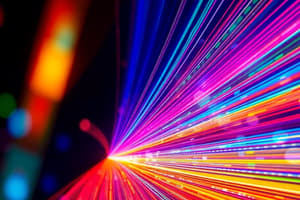Podcast
Questions and Answers
Wavelength Division Multiplexing (WDM) combines light signals at the same wavelength into a single fiber.
Wavelength Division Multiplexing (WDM) combines light signals at the same wavelength into a single fiber.
False (B)
Active networks do not utilize amplifiers or repeaters, making them less capable of long-range communication.
Active networks do not utilize amplifiers or repeaters, making them less capable of long-range communication.
False (B)
Fiber optic cables are more susceptible to electromagnetic interference compared to copper cables.
Fiber optic cables are more susceptible to electromagnetic interference compared to copper cables.
False (B)
Passive networks use electronic devices such as amplifiers to boost signals.
Passive networks use electronic devices such as amplifiers to boost signals.
Fiber optic cables can transmit data over long distances with lower attenuation and signal loss compared to copper cables.
Fiber optic cables can transmit data over long distances with lower attenuation and signal loss compared to copper cables.
The speed of light in a vacuum is 300,000 km/s.
The speed of light in a vacuum is 300,000 km/s.
Total internal reflection occurs when light travels from a medium with a lower refractive index to one with a higher refractive index.
Total internal reflection occurs when light travels from a medium with a lower refractive index to one with a higher refractive index.
Single-mode fibers have a core diameter of around 50 to 60 micrometers.
Single-mode fibers have a core diameter of around 50 to 60 micrometers.
Light can travel through fiber optic cables by repeatedly reflecting off the cladding.
Light can travel through fiber optic cables by repeatedly reflecting off the cladding.
Multimode fibers are better suited for long-distance applications due to their higher data transfer rates.
Multimode fibers are better suited for long-distance applications due to their higher data transfer rates.
The protective sheath of a fiber optic cable is primarily designed to enhance signal transmission.
The protective sheath of a fiber optic cable is primarily designed to enhance signal transmission.
Lasers are typically used for short-distance applications in fiber optic communications.
Lasers are typically used for short-distance applications in fiber optic communications.
The refractive index is the ratio between the speed of light in a specific medium and the speed of light in a vacuum.
The refractive index is the ratio between the speed of light in a specific medium and the speed of light in a vacuum.
Flashcards
Wavelength Division Multiplexing (WDM)
Wavelength Division Multiplexing (WDM)
Combines multiple light signals at different wavelengths into a single fiber, increasing the data transfer rate.
Receiver/De-multiplexer
Receiver/De-multiplexer
A device that converts incoming light signals back into electrical signals, separating the combined signals and sending them to their destinations.
Passive Fiber Optic Network
Passive Fiber Optic Network
Fiber optic networks that don’t use electronic devices for signal amplification, offering energy efficiency and lower cost but limited range.
Active Fiber Optic Network
Active Fiber Optic Network
Signup and view all the flashcards
Fiber Optic Cables
Fiber Optic Cables
Signup and view all the flashcards
Refractive Index
Refractive Index
Signup and view all the flashcards
Refraction
Refraction
Signup and view all the flashcards
Total Internal Reflection
Total Internal Reflection
Signup and view all the flashcards
Fiber Optic Cable Core
Fiber Optic Cable Core
Signup and view all the flashcards
Fiber Optic Cable Cladding
Fiber Optic Cable Cladding
Signup and view all the flashcards
Single-mode Fiber
Single-mode Fiber
Signup and view all the flashcards
Multimode Fiber
Multimode Fiber
Signup and view all the flashcards
Data to Light Conversion
Data to Light Conversion
Signup and view all the flashcards
Study Notes
The Speed of Light and Refractive Index
- Light travels at varying speeds depending on the medium it traverses.
- The speed of light in a vacuum is 300,000 km/s.
- The refractive index quantifies the ratio of light's speed in a vacuum to its speed in a specific material.
- Each material possesses a unique refractive index.
Refraction and Total Internal Reflection
- Light's path alters when transitioning between mediums with disparate refractive indexes.
- This directional shift is termed refraction.
- When the angle of incidence is substantial enough, light reflects back into the initial medium.
- This phenomenon is known as total internal reflection.
- Total internal reflection arises when light moves from a denser material (higher refractive index) to a less dense material (lower refractive index).
- This principle is fundamental to fiber optic cable operation.
Components of a Fiber Optic Cable
- Fiber optic cables comprise three primary layers:
- Core: A slender transparent strand of glass or plastic that transmits light.
- Cladding: Encases the core, composed of glass or plastic with a different refractive index than the core.
- Protective Sheath: An outer layer safeguarding the cable from physical damage, typically made of plastic, Kevlar, or steel.
How Light Travels Through a Fiber Optic Cable
- Light entering the core experiences repeated reflections off the cladding due to total internal reflection.
- This confinement of the light beam within the core facilitates long-distance transmission.
Types of Fiber Optic Cables
- Single-mode Fibers:
- Possess a narrow core (approximately 9 micrometers in diameter).
- Permit light to propagate in a single, straight path with minimal signal loss.
- Ideal for long-distance transmissions.
- Multimode Fibers:
- Feature a wider core (approximately 50 to 60 micrometers in diameter).
- Simultaneously transmit multiple light signals, each following a slightly different path.
- Enable higher data transfer rates but may experience signal degradation over extended distances.
- Better suited for short-range applications such as local area networks (LANs) and data centers.
Converting Data to Light Signals
- Digital data (text, images, video) is transformed into binary light signals using:
- LEDs: Economical and employed for short-range applications.
- Lasers: Generate more coherent and powerful light beams, suitable for extended distances and high speeds.
Multiplexing Techniques
- Wavelength Division Multiplexing (WDM):
- Combines several light signals at distinct wavelengths into a single fiber.
- Enhances data transfer rates.
Receiving Light Signals
- Light signals reaching their destination are converted back to electrical signals by receivers or demultiplexers.
- The demultiplexer separates the combined signals and directs them to the appropriate device or network.
Fiber Optic Network Types
- Passive Networks:
- Eschew electronic devices (amplifiers, repeaters) for signal boosting.
- More energy-efficient and economical but have restricted range.
- Active Networks:
- Employ amplifiers or repeaters to amplify the signal.
- Facilitate longer transmission distances.
Advantages of Fiber Optic Cables over Copper Cables
- Enhanced Bandwidth and Data Transfer Rates: Speeds up internet speeds and communication efficiency.
- Immunity to Electromagnetic Interference: Provides a more reliable and stable connection.
- Reduced Attenuation and Signal Loss: Enables efficient data transmission over substantial distances.
- Reduced Size and Weight: Simplifies installation and cuts infrastructure costs.
- Improved Security: Absence of electrical signals minimizes susceptibility to eavesdropping and data interception.
Studying That Suits You
Use AI to generate personalized quizzes and flashcards to suit your learning preferences.




